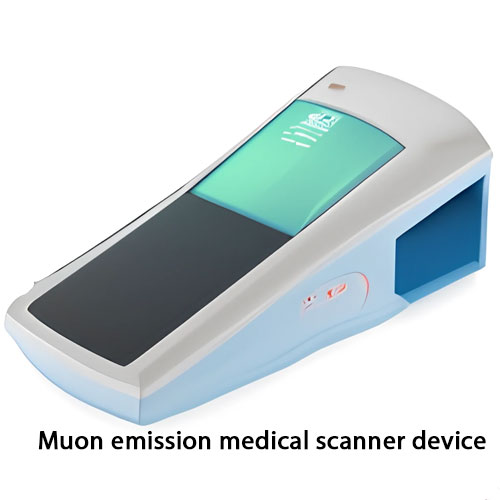muon emission medical scanners
Humanity has always been able to overcome many problems with the help of physics, by creating tools and devices that have made the way smooth, both in medicine and in other fields. Especially particle physics, which has created wonders in our world. Devices such as MRI or other medical scanners are all desired outcomes of particle physics.
Medical scanners and their large sizes
Medical scanners such as MRI are very useful devices that have saved many lives so far. Although MRI is a practical device, its fundamental problem is its size, both in terms of the device structure and its cost.
In fact, MRI machines are large in size and also have a high cost, which has caused some areas to be deprived of this device, and even in space projects, it may not be possible to bring such a device into space for astronauts to use if necessary. You may ask yourself, is it necessary for space? It is true that so far in 2023, astronauts have not needed an MRI machine, but soon with the increase in space travel and settlement on other planets, such devices will be needed.
Also, in the same vein, there are many cities and regions that do not have access to medical imaging devices such as MRI or other medical imaging equipment, or they are far from the nearest medical imaging center. The main reason that some areas, which are not few in number, do not have easy access to such equipment is the high cost and size of the device, as well as transportation problems. More importantly, there are not many specialists who want to work with such devices, and even if they do, they are not many, and the cost of maintenance, which requires specialists who can always operate the device and check technical issues so that the devices do not malfunction. These factors combine to prevent large, heavy, and expensive devices from being available to everyone.
What is the solution? And what are the shortcomings and how do modern medical imaging devices work?
It seems like a dream or a fantasy to have a scanner device that is the size of a mobile phone but has the ability to scan the body like an MRI. It would be great. Why hasn’t such a device been developed yet? The reason is technical, as modern medical imaging devices rely on it.
For example, an MRI device has a giant electromagnet that is activated at a high frequency. When the MRI electromagnet is activated, it creates such a strong magnetic field that causes all the atoms in the body to align with the magnetic field (of course, most water molecules and atoms are susceptible to magnetic fields) and then these movements of the body’s atoms emit weak radio waves that the device’s sensors receive, and in this way, an image of the inside of the body is obtained.
So the first thing that an MRI device requires is the creation of a very strong magnetic field, and creating such a magnetic field requires a strong electromagnet made of a wire coil, and the driver circuit for it has made modern MRI devices large and heavy.
Medical scanners are as small as mobile phones
One of the solutions that will revolutionize medical imaging devices is to have the same MRI imaging power in a small device as small as a mobile phone. In this case, all regions of the world can have access to such a device. Certainly, when research is conducted in the field of particle physics with the aim of building medical imaging devices, such devices can be achieved in the coming years.
Currently, we have good technologies for building such devices. For example, in terms of electronic device engineering, we can create many things in small dimensions, and we have also made great strides in physics.
One of the scenarios for creating a particle-based medical imaging device in the size of a mobile phone is to use a fundamental particle called muons. Muons are particles that are very similar to electrons and have a negative charge, but they are 207 times heavier than an electron. Muons move at a very high speed close to the speed of light and belong to the lepton family of particles.
These particles, due to their heaviness, are almost unstoppable and, because they are fundamental and very small, they do not interact with objects during their passage through them. Muon particles can easily pass through dense materials due to this property. Scientists have been able to produce 3D images of atomic reactors using muon particles, as well as produce good images of ancient structures such as the pyramids of Egypt, all of which demonstrate the widespread use and application of muon particles. Additionally, the lifespan of a muon particle is about 2.5 microseconds, after which it decays into a neutrino and an electron. However, due to their high speed, they travel a considerable distance during this very short period of time, making it possible to use these particles for medical imaging devices.
Muons, due to their high mass and negative electric charge, experience a decrease in their speed when interacting with the atoms of matter (although this decrease in speed does not result in any specific interaction). They also change direction in their path. This property makes muons a very useful tool for physical research as they can serve as a tracer for various phenomena.
Moreover, muons as one of the fundamental particles in particle physics are very important in research on the structure of the universe. For example, the motion pattern of muons in particle accelerators can be used to investigate the structure of atoms and nuclei.
Exactly, based on the properties of the muon particle, it can also be used for imaging inside the human body. However, developing a commercial and complete device for this purpose requires further research in this field.
For this purpose, violetcyber company is conducting research and study on this subject and is launching a startup in this field. Soon, it will create a call to invite investors and experts to start more extensive research until the production of an initial commercial device. You can follow the latest news on this subject through our website and be a spectator of violetcyber laboratory.

